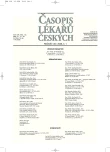The Use of Quantitative Assessment of Wilms Tumour Gene for Monitoring of Residual Disease in Acute Myeloid Leukemia Patients
Užití kvantitativního stanovení exprese genu Wilmsova tumoru 1 pro monitorování reziduální nemoci pacientů s akutní myeloidní leukémií
Východisko.
U většiny pacientů s akutní myeloidní leukémií nebyl dosud nalezen vhodný specifický marker pro monitorovaní minimální reziduální nemoci (MRN). Výsledky publikované v některých pracích navrhují gen Wilmsova tumoru 1 (WT1) jako potencionální marker MRN. V naší studii jsme sledovali expresi genu WT1 při diagnóze a v průběhu léčby u pacientů s akutní myeloidní leukémií.
Metody a výsledky.
Exprese genu WT1 byla měřena metodou kvantitativní RT-PCR v reálném čase v leukocytech periferní krve 56 pacientů s AML při diagnóze a 7 pacientů s AML transformovanou z myelodysplastických syndromů (MDS). Exprese genu WT1 byla u pacientů signifikantně zvýšena ve srovnání s hladinou jeho exprese v leukocytech periferní krve zdravých dárců (P<0,0001). Nejvyšší expresi genu WT1 jsme nalezli u pacientů s AML se subtypem M4, M1, M3 a u AML transformované z MDS. Naopak pacienti se subtypem M2 a s přítomností fúzního genu AML1/ETO při diagnóze vykazovali signifikantně nižší expresi genu WT1 než ostatní pacienti s AML. Dále jsme sledovali expresi genu WT1 v průběhu léčby u 12 pacientů AML souběžně s expresí specifických markerů minimální reziduální nemoci fúzních genů: AML1/ETO, PML/RAR a CBFB/MYH11. Exprese genu WT1 a výše zmíněných specifických markerů MRN korelovala na vysoké hladině signifikance. Rovněž jsme sledovali expresi genu WT1 v průběhu onemocnění u 14 pacientů bez přítomnosti specifického markeru MRN. Hematologické relapsy u těchto pacientů byly spojeny s paralelním nárůstem exprese genu WT1 a příslušných specifických markerů MRN. U čtyřech dlouhodobě sledovaných pacientů jsme pozorovali nárůst exprese genu WT1 nad hladinu u zdravých dárců (molekulární relaps) s výrazným předstihem před hematologickým relapsem.
Závěry.
Naše výsledky ve shodě s některými již publikovanými pracemi ukazují na možnost sledování exprese genu WT1 u AML jakožto vhodného markeru MRN.
Klíčová slova:
leukémie, akutní myeloidní leukémie, Wilmsův tumor 1, minimální reziduální nemoc.
Authors:
J. Polák; J. Marková; J. Schwarz; J. Maaloufová; Z. Volková; J. Čermák; C. Haškovec
Authors‘ workplace:
Ústav hematologie a krevní transfuze, Praha
Published in:
Čas. Lék. čes. 2006; 145: 36-42
Category:
Original Article
Overview
Background.
Despite a considerable effort, the majority of acute myeloid leukaemia (AML) patients do not have a suitable specific molecular marker for monitoring minimal residual disease (MRD). The results of some studies suggest the Wilms tumour gene (WT1) as a possible molecular marker of MRD.
Methods and Results.
We measured the expression of WT1 at diagnosis and during treatment of the acute myeloid leukaemia (AML) patients. The expression of WT1 was measured by the quantitative real-time RT-PCR in peripheral leukocytes from 56 AML at diagnosis and 7 patients with AML transformed from myelodysplastic syndromes (MDS). The WT1 expression was significantly elevated (up to 3 orders of magnitude) in peripheral blood samples (PB) of AML patients at diagnosis compared to PB samples of healthy donors (P<0.0001). The level of WT1 expression depends particularly on FAB AML subtype, with the highest being found in AML patients with subtypes M4, M1, M3 and AML transformed from MDS. Conversely, AML patients with M2 and with the presence of AML1/ET0 at presentation showed a significantly lower expression of the WT1 gene compared to the remaining AML patients at presentation (P = 0,005). Further, sequence samples of 12 AML patients under long-term surveillance were tested for the WT1 expression in parallel with the expression of specific MRD markers - fusion genes: AML1/ETO, PML/RARα and CBFB/MYH11. The levels of WT1 gene expression and the above specific fusion genes significantly correlated. Moreover, 14 patients without the specific MRD marker were tested for the WT1 expression. The results show that haematological relapses were associated with the rise of expression of the specific fusion genes and with the WT1 gene expression. The rise of WT1 expression above the level seen in leucocytes from peripheral blood and/or bone marrow of healthy donors – in four patients under long-term surveillance the „molecular relapse” predicted ongoing haematological relapses as early as 2 months in advance.
Conclusions.
Our results, in accordance with some of the previously published ones, show that WT1 expression seems to be a suitable marker of minimal residual disease in AML patients.
Key words:
leukemia, acute myeloid leukaemia, Wilms tumor 1, minimal residual disease.
Labels
Addictology Allergology and clinical immunology Angiology Audiology Clinical biochemistry Dermatology & STDs Paediatric gastroenterology Paediatric surgery Paediatric cardiology Paediatric neurology Paediatric ENT Paediatric psychiatry Paediatric rheumatology Diabetology Pharmacy Vascular surgery Pain management Dental HygienistArticle was published in
Journal of Czech Physicians

- Advances in the Treatment of Myasthenia Gravis on the Horizon
- Metamizole at a Glance and in Practice – Effective Non-Opioid Analgesic for All Ages
- What Effect Can Be Expected from Limosilactobacillus reuteri in Mucositis and Peri-Implantitis?
- Spasmolytic Effect of Metamizole
- Metamizole vs. Tramadol in Postoperative Analgesia
Most read in this issue
- Impact Factor – Good Servant, but a Bad Master
- Acute Toxicity of High Dose Interstitial Brachytherapy Boost in Prostate Cancer
- Abuse of Buprenorphine Becomes a Problem of the Czech Republic
- Principle and Importance of Using the Array CGH in Hematooncology
